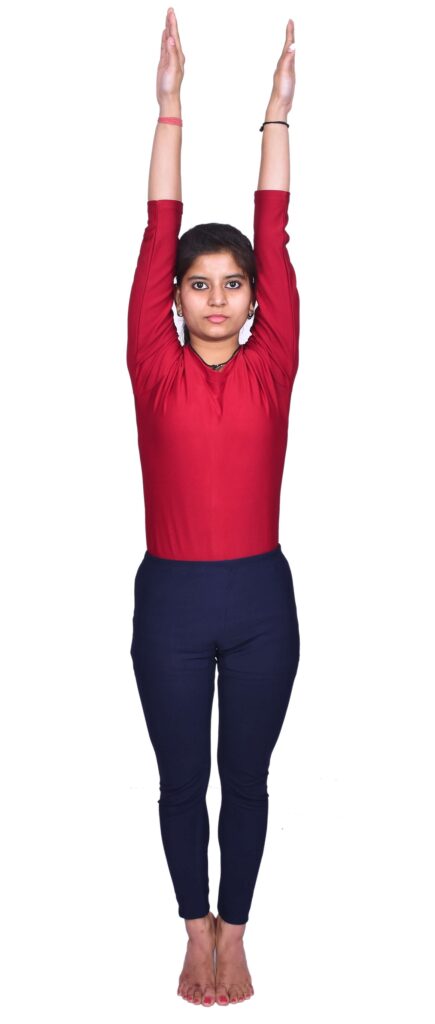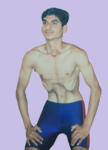Meaning of Tadasana
Let’s know what mountain pose is. Mountain pose or Palm tree pose is the base of all the standing yoga poses and one of the effective yoga asanas that give complete stretching and relaxation from toes to fingers. There are few yoga poses that ensure whole muscular movement and stretching to the entire body, like mountain yoga. Along with athletic activities, nerves extending are uniformly distributed while practising this yoga. The easily explained steps, benefits, precautions, images, and videos of mountain pose-Tadasana will help you to understand heavenly yoga more systematically, thereby extracting maximum benefits from it.
Different names of Mountain pose
- Palm tree pose
- Tadasana
- Heavenly yoga
- The base of all standing yoga

How to do the Tadasana pose step by step
- First, one has to stand erect on the ground 10 cm apart between the legs.
- Initially, keep your arms beside your thighs.
- Now, inhale and raise your arms above your head.
- Both arms should be beside your head. It should be straight and stretched.
- Feel the stretching from toes to fingers.
- One can come on toes by raising the heels and feel the stretching evenly distributed to the entire body, i.e. from toes to fingers.
- One can also interlock one’s fingers while stretching the arms upwards in the final position.
- Maintain the pose as long as you can without movement
- Do breathing slowly and deeply.
- Exhale; slowly come to the original position.
- This is one round.
- One can perform 2 to 3 rounds at one’s convenience.
Breathing
The breathing mechanism and awareness of inhaling-exhaling are of utmost importance to extract the maximum benefits of a particular yoga pose. The same breathing rule is also observed with mountain yoga poses. Inhale slowly and deeply while raising your arms and coming on your toes. While maintaining the posture, do inhaling and exhale slowly. Deep exhale, slowly bring your arms down and come to the original position.
Muscular movements
The muscular movements, incredibly the finer muscular, are essential in yogic practices. Tadasana ensures adequate stretching from toes to fingers, ultimately stimulating the finer athletic activities and soothing stimulation in the nerve regions.
Video Courtesy: MDNIY
Mountain pose practice in different schools of Yoga
The main motto of practising Tadasana by other yoga schools is to have suitable stretching in the entire body, thereby getting maximum benefits. However, there are some differences in practising the palm tree pose in different schools.
- Iyengar yoga: The hands are kept above the head or by the side of the thighs.
- Vinyasa Yoga: The yoga pose is performed by coming on toes.
- Ashtanga Yoga: It is the beginning and last yoga of Suryanamaskar (Sun Salutation).
- Baba Ramdev yoga: Practicing by raising hands above head.
- Power yoga: Here, stretching, maintaining, and rigour of the posture is essential.
- Bikram yoga: It is Virksasana where hands are in namaskar mudra, standing in one leg and the other leg is folded at the knees, and toes are touching the upper part of the other thigh.
- Hot yoga: It is similar to power yoga but more strenuous.
Top 10 benefits of Tadasana
There are many benefits of the heavenly yoga pose. Some of the essential benefits are being mentioned here.
- Height increase: The pose helps to increase height at a younger age, especially up to 18-20 years old. If you want to increase your height, do it regularly. The maintenance time of the pose should increase gradually. While stretching to the body from toes to fingers, feels it on every part of the body and ensures no movements of body parts.
- Weight loss: The suitable stretching to the entire body helps to shed extra fat from toes to fingers. But for this, one has to maintain the pose regularly for an appropriate time. It helps to give a slim and smart body.
- Pain killer: To a more significant extent, it helps to reduce incredibly muscular and neurological pain. To have a soothing effect in pain, it is advisable to practice the pose slowly, calmly, and overall for longer. The asana is beneficial for back pain, lower spine, and from toes to fingers.
- Helps in walking: According to great yoga guru Dr BKS Iyengar, more than 90% of people don’t know how to walk, therefore having problems with soles, heels, toes, knees, thighs, legs, back, etc. Practising this asana regularly teaches one how to walk correctly and prevent many problems related to legs and thighs.
- Sciatica: Sciatica is a very acute condition. Selective yoga is required to treat the disease. One of the essential yoga poses is palm tree yoga, which helps treat sciatica. However, it is suggested to practice under the supervision of a yoga expert.
- Healthy nerves: It provides suitable flexibility to the entire body’s nerves, thus preventing you from many nerve-related problems.
- Concentration: It is good to increase the level of concentration. Therefore, students who need more attention must perform this yoga practice.
- Legs strengthening: It is suitable for legs, i.e. heels, ankles, knees, and thighs. It not only supports but also prevents deformities in the leg region. It is also suitable for hip mobility.
- Spinal elasticity: This is one of the best yoga poses for spinal health and elasticity.
- Flat feet: This yoga pose’s regular practice helps prevent flat feet.
Mountain pose contraindications
Some of the few precautions/limitations of Tadasana are:
- Pregnancy: Don’t practice it during pregnancy.
- Varicose vein: Avoid practising in case of varicose vein.
- Dizziness: It should be avoided in dizziness.
- Low BP: Skip it, as blood tends to accumulate in the lower region of the body.
- Headache: Don’t maintain for a long time.
- Insomnia: It should be maintained for a brief period.
- Knees: Do with care in case of knee problems.
Beginner’s Tips
For beginners, it is tough to perform with accuracy. Initially, achieve it by keeping hands beside the thighs. In the second stage, raise your hands beside your head and feel the stretching upwards. In the third and final stage, raise your heels, come on your toes, and keep your hands above by interlocking your fingers, which needs more balance, practice, and stamina. While performing the pose, try to focus your mind on stretching your body, especially with the finer muscles.
Mountain pose variations
- In the simple case, one has to stand erect by keeping the arms beside the thighs.
- Some yoga schools perform it by raising the arms above the head and interlocking fingers. Components are also kept parallel to each other and should be straight and stretched above the head.
- Some yoga schools perform the pose on the toes and interlocking fingers above the head.
- In some cases, namaskar mudra is also maintained.
Precautions
Some things could be improved, which must be avoided to gain the maximum benefits of this yoga pose.
- While maintaining the pose, movement should be restricted, or there should be no movement.
- Having pain in the legs shouldn’t be practised.
- While performing the asana, you must focus and concentrate at a particular point to attain stability, thereby getting maximum benefits.
Preparatory pose
Tree posture (Vrikshasana )
- Warrior pose (Virbhadrasana)
- Headstand yoga (Sirsasana)
- Shoulder stand pose (Sarvangasana)
- Standing forward bend (Uttanasana)
- Stick asana (Yastikasana)
Follow-up / counterpose
- Sirsasana
- Sarvanasana
- VipritKarni
The science behind Mountain Pose
The very base of anatomy, physiology and movement of finer muscles due to this yogasana ensures all the standing yoga poses are correctly performed. The various body muscles, i.e., intrinsic and extrinsic muscles of the feet, quadriceps, iliopsoas, and abdominal muscles, among other yogasana. Quadriceps femoris and ischial tuberosities balance the knees. The abductor muscles hold the thighs together. If the hands are raised upward, the thoracic muscles are involved.







1 thought on “How To Do Tadasana-Steps, Benefits And Precautions”